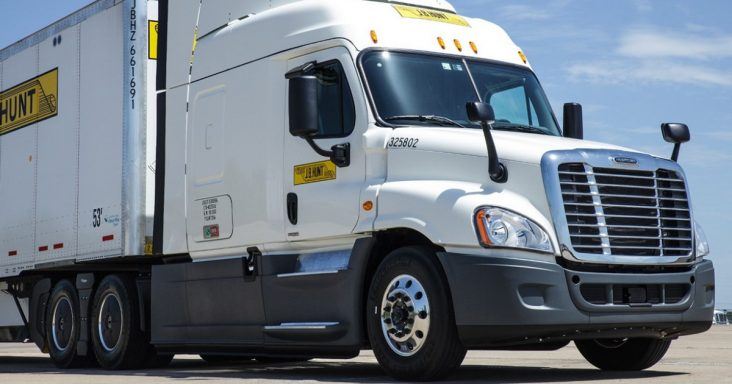Fourth-quarter earnings reports mixed for truckload, LTL carriers; 2018 earnings estimates revised
by February 28, 2018 10:59 am 433 views

Across the trucking/transportation industry, carriers reported mixed fourth-quarter earnings after a strong peak season and better freight opportunities in the period, said Brad Delco, industry analyst for Little Rock-based Stephens Inc.
In January, pricing continued to rise and demand was above seasonal strength for truckload carriers. For less-than-truckload carriers tonnage rose in the fourth quarter, but in January, it declined for some carriers because of weather disruptions.
“We believe the tight (truckload) freight environment should continue to bode well for both the (truckloads) and (less-than-truckloads), but acknowledge we are entering into a seasonally weak period for freight demand and see any sustained weakness in the group as buying opportunities” for buy-rated companies Stephens covers, Delco said. It has buy ratings for J.B. Hunt Transport Services and USA Truck.
On Jan. 18, Lowell-based J.B. Hunt said its fourth-quarter earnings rose 227.8% to $385.308 million, or $3.48 per share. Revenue rose 15.6% to $1.99 billion. On Jan. 31, Fort Smith-based ArcBest, parent company of less-than-truckload carrier ABF Freight, said earnings for the period that ended Dec. 31 rose 53% to $11.186 million. Revenue increased 3.3% to $710.721 million.
On Feb. 1, Van Buren-based USA Truck said fourth-quarter earnings rose to $14.822 million, or $1.84 per share, compared to a $3.812 million loss, or a 48 cents per share loss in the same period in 2016. Revenue increased 19.5% to $123.27 million. On Feb. 15, Tontitown-based P.A.M. Transportation Services reported net income increased 4,266.3% to $31.561 million, or $5 per share, from $722,842, or 11 cents per share. Revenue rose 2.3% to $110.889 million.
MIXED REPORTS
Among the carriers Stephens follows, it saw mixed earnings reports based on analysts’ expectations. Three of its truckload carriers beat expectations, two missed and two were inline. Two less-than-truckload carriers beat expectations, one missed and another was inline.
In 2018, analysts expect carriers to improve earnings results as a result of lower tax rates from federal tax law changes, and after the carriers Stephens covers reported earnings, analysts revised truckload carriers’ earnings estimates for the year, with the estimates among the group increasing 12.7%. USA Truck’s earnings per share estimate for 2018 was increased 51.1% to $1.33 per share, from 88 cents. Less-than-truckload carriers’ earnings estimates for 2018 increased 6%. ArcBest’s earnings projections were increased 5.5% to $2.31 per share, from $2.19.
Since carriers reported earnings, stock performance for truckload carriers has fallen 6%, while stock performance for less-than-truckload carriers rose 3.5%.
Based on fourth-quarter operating results compared to the same period in 2016, USA Truck was among the top performers for truckload companies, while ArcBest was one of the less-than-truckload companies with the best results. Some of the metrics Delco looked at included revenue per mile and average miles driven per tractor for the truckload carriers, and for less-than-truckload carriers, he reviewed tonnage growth, yields and operating ratios.
“We are encouraged about the current freight market and earnings outlook looking ahead to 2018 and beyond given our view that we have reached the next cyclical inflection, particularly heading into spring peak season and the hard enforcement of the ELD mandate on April 1,” he said.
In the fourth quarter, spot rates rose 20% on average as a result of tight truckload capacity and a stronger peak season, compared to 2016, according to Delco. The strength continued into January, based on earnings conference calls, analyst checks and industry data. Less-than-truckload tonnage grew as projected, driven by growth in PMI data over the past 17 months, which supports Delco’s belief that the industrial economy remains strong.
However, some less-than-truckload companies, such as ArcBest, reported tonnage declined in January as a result of winter weather and some competitors increasing market share in the sector. Tonnage growth could accelerate if truckload capacity remains tight, as the industry heads into full ELD enforcement starting April 1, and freight demand spills over into the less-than-truckload sector, Delco said.
RISING RATE INDICES
The Stephens Truckload Rate Index rose 7.8% in the fourth quarter, from the same period in 2016. The index, which includes data from companies such as J.B. Hunt and USA Truck, had the largest fourth-quarter sequential rise in the history of the index, starting in 1998. USA Truck saw 20.2% rate increases.
“We believe carriers were able to be more selective with freight selection in the quarter, servicing more premium/higher yielding freight, particularly post the hurricanes with some carriers taking advantage of the spot market/surge capacity,” Delco said.
The Stephens Less-Than-Truckload Index rose 2.1% in the fourth quarter. Weight per shipments has increased, and this suggests that truckload spillover is happening, according to Delco.
Since the start of 2018, dry-van spot rates have risen 30% on average, and this is the highest average over the period in the history of the Stephens’ dataset. In 2014, rates rose 23% over the period.
“We believe that January and early February trends have continued to show above seasonal strength, with some checks recently noting record turndowns and strongest January seen in years (if not ever seen),” Delco said. “While we believe some of the strength is partly a result of lingering peak season freight into early January, we also believe the sustained improvement is indicative of early impacts from the ELD mandate that went into effect in December. We believe the subsequent hard-enforcement (April 1, 2018) during which drivers and their trucks in violation of (hours of service) will be taken out-of-service, will be the next significant industry catalyst as it also falls during the start of the spring peak season.”
